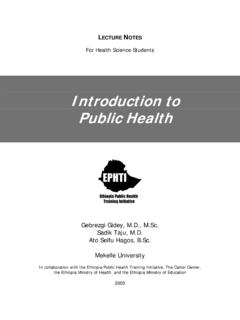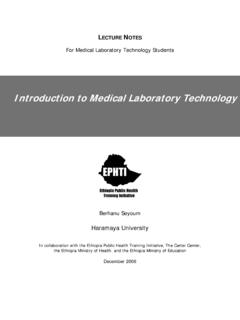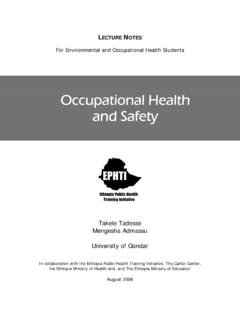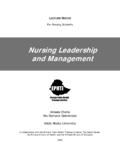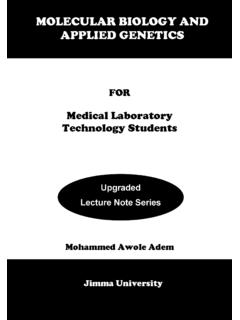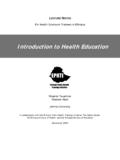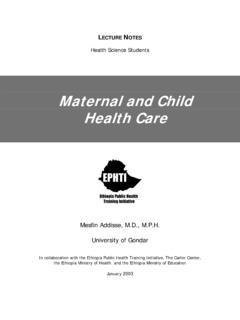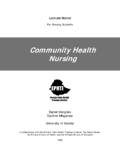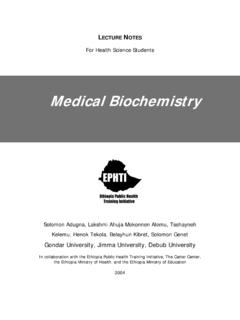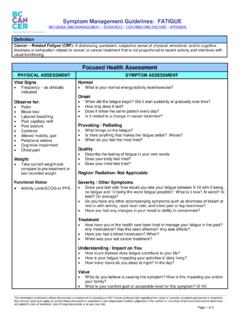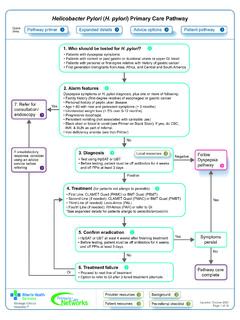Transcription of Pediatric Nursing and Health Care - Carter Center
1 LECTURE NOTES For Nursing Students Pediatric Nursing and Health care Teklebrhan Tema Tsegaye Asres Jimma University In collaboration with the Ethiopia Public Health Training Initiative, The Carter Center , the Ethiopia Ministry of Health , and the Ethiopia Ministry of Education 2003 Funded under USAID Cooperative Agreement No. 663-A-00-00-0358-00. Produced in collaboration with the Ethiopia Public Health Training Initiative, The Carter Center , the Ethiopia Ministry of Health , and the Ethiopia Ministry of Education. Important Guidelines for Printing and Photocopying Limited permission is granted free of charge to print or photocopy all pages of this publication for educational, not-for-profit use by Health care workers, students or faculty. All copies must retain all author credits and copyright notices included in the original document.
2 Under no circumstances is it permissible to sell or distribute on a commercial basis, or to claim authorship of, copies of material reproduced from this publication. 2003 by Teklebrhan Tema and Tsegaye Asres All rights reserved. Except as expressly provided above, no part of this publication may be reproduced or transmitted in any form or by any means, electronic or mechanical, including photocopying, recording, or by any information storage and retrieval system, without written permission of the author or authors. This material is intended for educational use only by practicing Health care workers or students and faculty in a Health care field. Pediatric Nursing and child Health care i Preface This lecture note on Pediatric and child Health is written for nurses at diploma level by considering the epidemiology and the burden of illness on younger age groups.
3 In this lecture note, the authors present concise summaries of the evidence that has been published in the scientific journals and texts which have a similar profile in the Ethiopian context. Since the authors have had so many years of teaching experience, emphasis is given on those lessons learned from experience. Pediatric Nursing and child Health care ii Acknowledgments The authors acknowledge The Carter Center (EPHTI) Addis Ababa, Ethiopia for their financial support and encouragement. Dr. Hailu Nida, assistant professor of Pediatric and child Health Jimma University, School of Medicine and Sr. Bosna Tebeje, Lecturer, at Jimma University School of Nursing deserve special thanks for their invaluable comments on the lecture note at the intra-institutional work shops in Agaro.
4 Nega Assefa and Sr. Meselech Asigid both from Alemaya University and Yosief Tsige from Jimma University need to receive warm appreciations for their immense contribution during the inter-institutional work shops in Addis Ababa. Last but not least, students at Jimma University, particularly in the school of Nursing , deserve special thanks for their active participation during the process of testing this manual in the class-room setting. Pediatric Nursing and child Health care iii TABLE OF CONTENTS Preface i Acknowledgement ii Table of content iii List of tables and figures viii Abbreviations ix CHAPTER ONE.
5 INTRODUCTION TO CHILD Health 1 Introduction 1 Safe motherhood and antenatal care . 2 Age and diseases pattern 5 Health priorities in children 7 care of the Under-Fives 9 Study Questions 12 CHAPTER TWO: HISTORY TAKING AND PHYSICAL EXAMINATION 13 History taking and approach 13 Review of System 17 Physical Examination 18 Study Questions 23 CHAPTER THREE: ESSENTIAL Nursing care FOR HOSPITALIZED CHILDREN 24 Administration of drugs 24 Pediatric Nursing and child Health care iv Indications and use of naso-gastric tube 27 care of child under specific conditions 32 Tracheostomy care 36 Study Questions 40 CHAPTER FOUR: care OF THE NEW BORN 41 care of normal new born 41 Causes of low birth weight 44 Perinatal and infant infections 51 Post neonatal and infant morbidity 52 Neonatal resuscitation 52 Fever 54 Convulsions 55 Feeding Recommendations during sickness and Health 57 Study Questions 59 CHAPTER FIVE: CONGENITAL ABNORMALITIES 60 Introduction 60 Types of commonest congenital anomalies 61 Umbilical hernia 65 Congenital Hypertrophic pyloric stenosis 66 Phimosis and paraphimosis 68 Spinal Bifida 69 Hydrocephalus 71 Neonatal Jaundice 73 Study Questions 75 Pediatric Nursing and child Health care v CHAPTER SIX: NORMAL GROWTH AND DEVELOPMENT 76 Growth 77 Development 79 Study Questions 84 CHAPTER SEVEN.
6 NUTRITION AND NUTRITIONAL DEFICIENCIES 85 Normal feeding pattern 86 Assessment of Nutritional status 89 Protein Energy Malnutrition 91 Micronutrient and its deficiency 95 Study Questions 102 CHAPTER EIGHT: ACUTE RESPIRATORY INFECTIONS 103 Introduction 104 Management of Children with ARI 105 Antbiotic Treatment 110 Home care 111 Referral Criteria 112 Croup or Obstructive Laryngitis 112 Tonsilitis, Pharyngitis 114 Chronic Tonsilitis and Adenoditis 115 Ear Infections 116 Study Questions 118 Pediatric Nursing and child Health care vi CHAPTER NINE: CONTROL OF DIARRHEA 119 Introduction 119 Types of diarrhea 120 Why is diarrhea dangerous? 120 How does diarrhea cause dehydration? 121 Treating Diarrhea 121 Prevention of dehydration 122 Feeding 122 Oral rehydration therapy 123 Assessment of a child with diarrhea 124 Treatment of Diarrhea 129 To treat diarrhea at home use treatment plan A 130 Study Questions 135 CHAPTER TEN: SYSTEMIC DISEASES 136 Cardiovascular system (CVS) disorder 136 Central nervous system Diseases 144 Epilepsy/ Seizure 147 Congenital heart Disease 150 Nephritic Syndrome 153 Urinary Tract Infection 155 Tuberculosis 157 Disease of the Skin 160 Other problems 163 Ophthalmic neonatrum 165 Congenital Syphilis 167 Pediatric Nursing and child Health care vii CHAPTER ELEVEN.
7 VACCINE PREVENTABLE DISEASES 168 Justification for immunization 168 Immunization schedule 169 Hazards of immunization 170 Study Questions 174 UNIT TWELVE: EXPANDED PROGRAM ON IMMUNIZATION (EPI) 175 Strategies of EPI service Delivery 176 Contraindications 178 Sterilization 179 Principles of the immunization program 179 Study Questions 180 UNIT THIRTEEN: COMMON GENETIC PROBLEMS OF CHILDREN 181 Mental retardation 181 Cerebral Palsy 183 Down s Syndrome 184 Cretinism/ hypothyroidism 186 Juvenile Diabetes Mellitus 186 Study Questions 188 BIBLIOGRAPHY 189 Pediatric Nursing and child Health care viii TABLES AND FIGURES Table One: Normal growth and development 78 Table Two: Summary of normal development 83 Table Three: Gomeze classification of nutritional status 90 Table Four: Interpretation of the findings on growth chart 90 Table Five: Signs and classifications of malnutrition Table Six a: Acute respiratory infection chart in children less than two months.
8 109 Table Six b: Acute respiratory infection chart in children 2 months to 4 years if age. 110 Table Seven: assessment of ear problems 117 Table Eight: Chart for assessing dehydration in patients on diarrhea. 125 Table Nine: Amount of estimated` ORS solution 131 Table Ten: treatment plan C to treat severe dehydrations quickly 133 Table Eleven: Child immunization scheme. 177 Table Twelve: Types of immunizations and route for administrations. 178 Pediatric Nursing and child Health care ix Abbreviations ABO Blood Group Type A,B, and O AIDS Acquired Immuno Defiencey syndrome ALRI Acute Lower respiratory Infections APGAR Appearance, Pulse, Grimace, Activity, and respirations ARI Acute Respiratory Infections BCG Bacillus Cal mate and Gurnee BP Blood Pressure CDD Control of Diarrhea Diseases CNS Central Nervous System CSF Cerebro Spinal Fluid CVA Costa vestibular angle ness DPT Diphtheria Pertusisi and Tetanus EPI Expanded Programmed on Immunizations GI Gastro Intestinal GUS Genuto Urinary Syndrome ICP Intra Cranial Pressure IM Intra Muscular IMCI Integrated management of child hood illness IV Intravenous NGT Naso gastric Tube PaO2 Partial pressure of Oxygen PEM Protein Energy
9 Malnutrition P'O By Mouth Pediatric Nursing and child Health care x PPF Procaine penicillin Fortified PRN When Necessary RBC Red Blood cells RH Rhesus factor TB Tuberculosis TTC Tetracycline VIT A Vitamin A Pediatric Nursing and child Health care 1 CHAPTER ONE INTRODUCTION TO CHILD Health Learning Objectives: After studying the material in this unit, the students will be able to describe: - Safe mother hood in relation to child Health - Age and disease patterns - Health priorities in children Introduction Throughout the world, poor women and children are the most vulnerable and the least served. In the less developed areas of the world, disease and death take the highest toll among mothers and children who make up over two-thirds of the population.
10 Perinatal mortality may be as much as ten times higher than that of infants born in industrialized countries; the infant mortality rate may be six to twenty times greater than that the industrialized regions of Europe and North America; the death rate among pre-school children is also up to ten times high. Furthermore, in underdeveloped countries, half of the total mortality may occur in children under 5 years of age compared to only 5% in countries such as United Kingdom Pediatric Nursing and child Health care 2 and Sweden. In technically advanced countries, the child survival rate is over 97% while in less developed countries over 50% of total deaths are of children under the age of 5, and the average life span is about 35 years.
